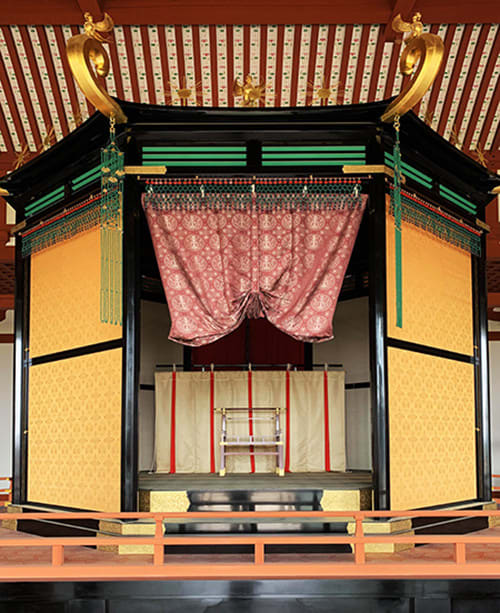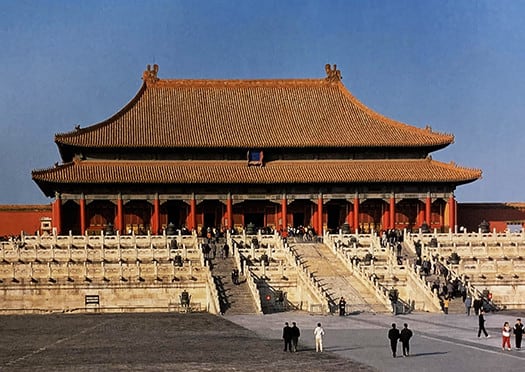


大極殿建築というものは、重要な国家行為の場であり
最重要な儀式を荘重化させる建築装置。
東アジア世界ではその中心建築思想として中華思想が広がった。
写真上は復元された「平城宮・大極殿」の高御座。
下は中国清国皇帝の北京紫禁城にある太和殿「玉座」。
日本の奈良平城京の建設、統一国家「日本」創始にあたっての
中華国家思想の象徴としての天皇の即位儀礼での玉座。


こちらは復元された平城宮・大極殿と
清朝当時のままに保全された北京紫禁城・太和殿の外観写真。
<紫禁城写真は国立歴史民俗博物館「日本建築は特異なのか」展図録より>
いかにも「中華思想」での権力支配を示そうという建築意図なのでしょう。
飛鳥京の時代を経てこの列島社会では統一政権が目指され、
そのモデルとして中国・唐のシステムが導入された。
多様な地域に在地型の支配システム・勢力が存在していた社会に
大陸国家的な制度が導入されていった。
律令制度というのは法概念であり、一方で同時に受容した仏教は
「世界宗教」という普遍性を持っていたのだろう。
よりゆるやかな各地域権力の八百万連合体的な権力形式から
違う系統の思想・中華思想での権力再構築というようにも思われる。
このような国家のありようがその後、時代の推移の中で「日本化」していく。
次に日本が世界のシステムを受容するのは明治だろうけれど、
そこでは欧米の社会システムが基本骨格になって
立憲君主制が理想的政体として目指された。
この平城京当時は、世界の政体システムとして皇帝による中華独裁が
もっとも進んだ政治システムだと認識していたのだと思う。
その後の社会進展で中国では「易姓革命」による暴力革命が繰り返され
一方の日本では王権は君臨すれど統治せず、という結果に落ち着いていった。
この復元された平城京の建築群はそういった国の経緯を知らせてくれる。
日本の王権、天皇家には「姓」がない。
「易姓」を繰り返す中国皇帝とは対極的なありよう。
姓は王権が民に「賜る」ものとされ王権自体には姓はない、というのは、
中国の「易姓革命」の苛烈さを体験した官僚機構システム成員たちが
そのように制度設計してきたのだと推測されている。
中国の歴世王朝や百済などの支配機構官僚成員が
過酷な殺戮での大陸的政変を目の当たりにしてから日本に帰化し
より「平和的」な政体を目指したのだという説。
また、地域有力者たちの連合体という大和王朝政体のありようが
このような仕組みとして残ったという説もある。
天武−持統期あたりで日本国号と天皇号が定められて構築されていった
この中華システムにもすでに「日本的変化」が仕組まれていた。
こういう日本化というものの動機分析ってあまり重視されない。
まるで宮内庁の管轄で学術的にも調査できない古墳のようでもある。
とにかく日本は中国的「中華」国家を基本にしながらも
その後の政治変革の改変においてもより「日本的」であったということ。
建築は社会の目指す方向を反映すると同時に
その社会の様子を知る大きな手掛かりをも後世に提供してくれる。
平城宮復元から多くの気付きがあるのだと思います。
憲法記念日周辺時期に思っていたことがらであります。
English version⬇
The Introduction of Chinese Philosophy and "Japanization": The Search for Heijo-kyo, Nara - 19
The Japaneseization of the emperor's "no family name" that systematically avoided the harsh easy family name revolution and violent revolution. Was there ingenuity in the introduction of Chinese ideology? ...
The Daigoku-den building is a place of important state action and an architectural device to solemnize the most important ceremonies.
It is an architectural device to solemnize the most important ceremonies.
In the East Asian world, Chinese thought spread as the central architectural idea.
The upper photo shows the restored Daigoku-den Hall of the Heijo Palace.
Below is the "Throne" of the Taihe Dian in the Forbidden City in Beijing, China by the Qing emperors.
The Emperor's throne as a symbol of the idea of the Chinese nation in the construction of the Heijo-kyo Capital in Nara, Japan, and in the founding of the unified nation of Japan.
The throne at the accession ceremony of the emperor as a symbol of the Chinese nationalistic ideology.
This is a photo of the restored Daigoku-den Hall of the Heijo Palace and the exterior of the Taihe-den Hall of the Forbidden City in Beijing.
and the exterior of Taihe Dian, Forbidden City, Beijing, preserved as it was in the Qing Dynasty.
<(Photo of the Forbidden City from the National Museum of Japanese History's "Is Japanese Architecture Unique?
The architectural intention of the Forbidden City was to demonstrate the power and dominance of the Chinese ideology.
After the Asuka-kyo period, the archipelago's society aimed for a unified government, and the Tang Dynasty in China was used as a model.
The Chinese Tang Dynasty system was introduced as a model for this system.
In a society where local ruling systems and forces existed in various regions, the system of a continental state was introduced.
The Ritsuryo system is a legal concept.
The Ritsuryo system was a legal concept, while Buddhism, which was accepted at the same time, had the universality of a "world religion.
Buddhism, on the other hand, was accepted as a "world religion" with universal characteristics.
The power structure seems to have shifted from a more loose federated power structure of 8 million regional powers
The reconstruction of power in the form of a federation of 8,000,000 regional powers, which is a different lineage of thought from that of the Chinese.
This type of nation-state was subsequently "Japanized" in the course of time.
The next time that Japan will accept the world system will be in the Meiji period.
The next time Japan would accept the world's system would be in the Meiji period, where the Western social system would become the basic framework.
The constitutional monarchy was aimed at as the ideal political system.
At the time of the Heijo-kyo Capital, the Chinese dictatorship by the emperor was recognized as the most advanced political system in the world.
The subsequent social development in China led to the development of the "easy surname" system.
Later, as society progressed, violent revolutions were repeated in China through the "Yi Surname Revolution.
In Japan, on the other hand, the king reigned but did not rule.
The restored Heijo-kyo Palace provides us with a glimpse into the history of the country.
The Japanese kings and emperors do not have "family names.
This is the opposite of the Chinese emperors, who repeatedly "changed their family name.
The surname is supposed to be "given" to the people by the royal power, and the royal power itself does not have a surname, which is a contrast to the Chinese emperors, who have repeatedly changed their surnames.
The fact that the surname system was designed by members of the bureaucratic system who experienced the harshness of China's "Yi Surname Revolution
It is assumed that this system was designed by the members of the bureaucratic system who experienced the harshness of the "Yi Surname Revolution" in China.
The bureaucratic members of the ruling system of China's successive dynasties and Baekje, etc.
After witnessing the continental political upheaval in China, they became naturalized Japanese citizens.
They were seeking to create a more "peaceful" political system.
The theory that the Yamato dynasty's system of government, which was a federation of local
The Yamato dynasty's system of government, which was a federation of local
Around the Temmu-Mochito period, the name of Japan and the name of the Emperor were established and constructed.
This Chinese system already had a "Japanese change" in place.
The analysis of the motive for this kind of Japanization is not given much importance.
It is as if the Imperial Household Agency had jurisdiction over the burial mounds, which cannot be studied even academically.
In any case, while Japan was based on a "Chinese" state, it was also a "Japanese" state in the sense that it was a "Chinese" state in the sense of China.
In any case, while Japan was based on the Chinese "Chinese" state, it was also more "Japanese" in its subsequent political transformation and modification.
Architecture reflects the direction of a society and at the same time
and at the same time, it provides future generations with a great clue as to the state of the society.
I believe that we can learn a lot from the restoration of Heijo Palace.
These are some of my thoughts around the time of Constitution Memorial Day.



















